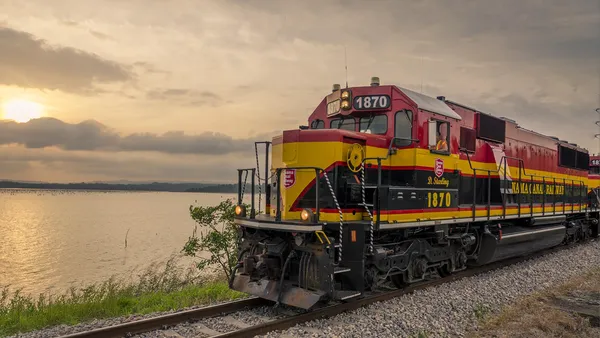Dive Brief:
- Just a few months after presenting its plan to implement the principles of precision-scheduled railroading (PSR) by 2021, Norfolk Southern is confident the strategy is already working. "We are finding that the more we adopt new practices and ideas, the more we can drive bottom line growth and shareholder value," said CEO Jim Squires on the railroad's first-quarter earnings call.
- Norfolk Southern decreased dwell time by 23% year-over-year in the first quarter while increasing train speed by 14% — two elements that contribute to the goal of improving overall efficiency at the railroad.
- The railroad's operating ratio, a general marker of efficiency at the heart of PSR transitions, is down to 66% (from 69.3% in Q1 2018). However, in PSR implementation, it's not as much the year-over-year improvements stakeholders are looking at — it's the change since introducing PSR principles that matter to most. The railroad's goal is to get this figure below 60% by 2021.
Dive Insight:
Norfolk Southern touted the early work it has done to streamline its network while making clear that the bulk of the work to drastically increase the railroad's efficiency and reliability is yet to come.
"We have started 2019 with positive momentum and are on track to deliver at least a 100 basis point improvement in our full year operating ratio," said CFO Cindy Earhart. "The additional capacity generated by Clean Sheeting set the stage for implementation of the new operating plan in the coming months, and as a result, the achievement of our financial goals."
"Clean sheeting" is the railroad's term for taking a fresh look at its network and removing unnecessary complexity wherever possible. The initial phase of this work is winding down now.
"The Clean Sheeting has really given us a lot of capacity out on the railroad to put in this new operating plan and that's what we're so excited about," said COO Mike Wheeler.
This process, along with increasing the speed of some trains to 60 miles per hour, has built an "excellent foundation" for the new operating plan, said Wheeler.
Along with operational changes, and theoretically, service improvements, the railroad has pledged to move to a "market-based pricing" system — essentially pairing improved service with increased prices. Just 10% of freight volume has so far felt this new strategy, and revenue was up 5% on Q1 2018. The pricing changes will continue to roll out gradually, the railroad said.
"Our customer-facing metrics are trending in a positive direction. As we continue improving our service product, we are effectively aligning with our customers for our mutual goals of more reliable and frequent service with better velocity," said Squires.














